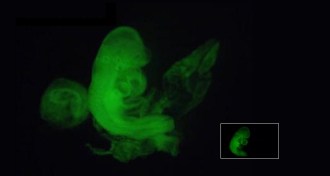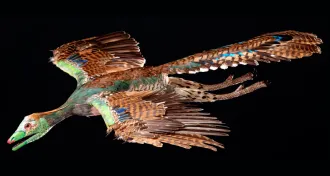Life
Sign up for our newsletter
We summarize the week's scientific breakthroughs every Thursday.
-
 Life
LifeDramatic retraction adds to questions about stem cell research
Researchers who reported an easy method for making stem cells admit mistakes mar their work, and have retracted their papers from Nature.
-
 Animals
AnimalsMantis shrimp tune their eyes with sunscreen
Blocking some rays in just the right way creates six ways of actually seeing ultraviolet light.
-
 Animals
AnimalsRed kangaroo’s tail acts like a fifth leg
Red kangaroos wield their tails like another limb when moving slowly.
-
 Paleontology
PaleontologyFlightless dino-bird wore full-body feathers
Recently unearthed Archaeopteryx fossil sports full coat of feathers, suggesting feather evolution was more complex than previously thought.
-
 Neuroscience
NeuroscienceAutism may carry a benefit: a buffer against Alzheimer’s
Brain plasticity of people with autism may protect them from Alzheimer’s disease, scientists propose.
-
 Life
LifeTibetans live high life thanks to extinct human relatives
DNA shared by modern-day Tibetans and extinct Denisovans suggests people picked up helpful genes through interbreeding with other hominids.
-
 Life
LifeStem cell papers retracted
Researchers who reported easy method for making stem cells admit mistakes mar their work, and have retracted their papers from Nature.
-
 Genetics
GeneticsFinally, some solid science on Bigfoot
DNA analysis finds no Bigfoot, no yeti, two weird bears and one scientist on a quest for the truth.
-
 Ecosystems
EcosystemsInvasive insect tied to shrinking river
A river in North Carolina shrank after a hemlock woolly adelgid eradicated eastern hemlock trees in the region.
-
 Life
LifeNear reefs, microbial mix dictated by coral and algae
A reef’s dominant organism, coral or algae, may determine what kind of bacteria live there.
-
 Neuroscience
NeuroscienceA mutated bacterial enzyme gobbles up cocaine
Cocaine is highly addictive, and those attempting to quit often relapse. Modifications to an enzyme that breaks down cocaine could help prevent abstinence setbacks.
-
 Animals
AnimalsEmperor penguin population could decline by 2100
Emperor penguins’ reign over Antarctic sea ice could be in decline by the beginning of the 22nd century.